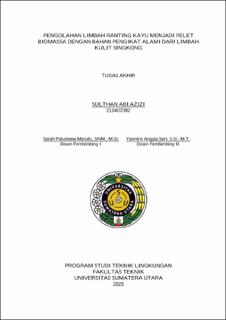Pengolahan Limbah Ranting Kayu menjadi Pelet Biomassa dengan Pengikat Alami dari Limbah Kulit Singkong
Processing Wood Branch Waste into Biomass Pellets with Natural Binders from Cassava Peel Waste

Date
2025Author
Azizi, Sulthan Abi
Advisor(s)
Manalu, Sarah Patumona
Sari, Yasmine Anggia
Metadata
Show full item recordAbstract
Wood branch waste and cassava peel waste are organic waste whose amount continues to increase
every year, but their utilization is not optimal, resulting in accumulation that causes aesthetic
damage and odor from the decomposition of the waste. In fact, wood waste has a high calorific
value of 4,300 cal/g, which is quite optimal as fuel, and cassava peel waste has a high starch
content of 93.46%, which can function as an adhesive in the manufacture of biomass pellet fuel.
Utilizing waste to make biomass pellet fuel is one effort that can be done to minimize waste
accumulation. This study aims to analyze the quality through the characteristics of the best
biomass pellets produced from wood twig waste with natural binder material cassava peel waste
according to SNI 8675-2018. This research method was carried out experimentally using a
Completely Randomized Design (CRD), by chopping, mixing the materials, compacting, drying
for 24 hours under the sun, and heating at a temperature of 105°C, a mixture of wood twig waste
and cassava peel waste adhesive with four variations of drying time, namely: (95%:5%) drying 2
hours, (95%:5%) drying 4 hours, (90%:10%) drying 2 hours, and (90%:10%) drying 4 hours with
two repetitions in each variation. The results showed that biomass pellet sample 4 (90%:10%) 4
hour drying, was the best biomass pellet with the highest calorific value (4,024 cal/g), bound
carbon content (11.83%), density (409 kg/m³), water content (8.35%), ash content (4.3%), volatile
matter content (75.6%), and combustion rate (0.241 g/minute). The characteristics of biomass
pellets produced from four samples met the standards for water content and ash content, but the
parameters of density, volatile matter content, bound carbon content, and calorific value did not
meet the characteristics of biomass pellets for energy according to SNI 8675-2018.
Collections
- Undergraduate Theses [404]
